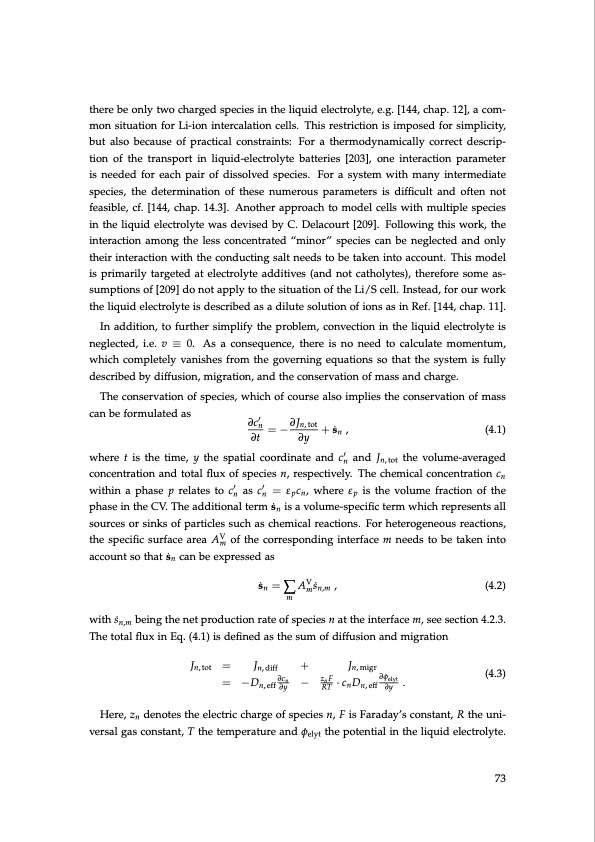
PDF Publication Title:
Text from PDF Page: 073
there be only two charged species in the liquid electrolyte, e.g. [144, chap. 12], a com- mon situation for Li-ion intercalation cells. This restriction is imposed for simplicity, but also because of practical constraints: For a thermodynamically correct descrip- tion of the transport in liquid-electrolyte batteries [203], one interaction parameter is needed for each pair of dissolved species. For a system with many intermediate species, the determination of these numerous parameters is difficult and often not feasible, cf. [144, chap. 14.3]. Another approach to model cells with multiple species in the liquid electrolyte was devised by C. Delacourt [209]. Following this work, the interaction among the less concentrated “minor” species can be neglected and only their interaction with the conducting salt needs to be taken into account. This model is primarily targeted at electrolyte additives (and not catholytes), therefore some as- sumptions of [209] do not apply to the situation of the Li/S cell. Instead, for our work the liquid electrolyte is described as a dilute solution of ions as in Ref. [144, chap. 11]. In addition, to further simplify the problem, convection in the liquid electrolyte is neglected, i.e. v ≡ 0. As a consequence, there is no need to calculate momentum, which completely vanishes from the governing equations so that the system is fully described by diffusion, migration, and the conservation of mass and charge. The conservation of species, which of course also implies the conservation of mass can be formulated as ∂c′n =−∂Jn,tot +s ̇n , (4.1) ∂t ∂y where t is the time, y the spatial coordinate and c′n and Jn,tot the volume-averaged concentration and total flux of species n, respectively. The chemical concentration cn within a phase p relates to c′n as c′n = εpcn, where εp is the volume fraction of the phase in the CV. The additional term s ̇n is a volume-specific term which represents all sources or sinks of particles such as chemical reactions. For heterogeneous reactions, the specific surface area AVm of the corresponding interface m needs to be taken into account so that s ̇n can be expressed as s ̇n =∑AVms ̇n,m , (4.2) m with s ̇n,m being the net production rate of species n at the interface m, see section 4.2.3. The total flux in Eq. (4.1) is defined as the sum of diffusion and migration Jn, tot = Jn, diff + Jn, migr (4.3) Here, zn denotes the electric charge of species n, F is Faraday’s constant, R the uni- versal gas constant, T the temperature and φelyt the potential in the liquid electrolyte. 73 = −D ∂cn n,eff∂y − znF·cD ∂φelyt . RT nn,eff∂yPDF Image | Lithium-Sulfur Battery: Design, Characterization, and Physically-based Modeling

PDF Search Title:
Lithium-Sulfur Battery: Design, Characterization, and Physically-based ModelingOriginal File Name Searched:
Dissertation_David_N._Fronczek_The_Lithium_Sulfur_Battery.pdfDIY PDF Search: Google It | Yahoo | Bing
Sulfur Deposition on Carbon Nanofibers using Supercritical CO2 Sulfur Deposition on Carbon Nanofibers using Supercritical CO2. Gamma sulfur also known as mother of pearl sulfur and nacreous sulfur... More Info
CO2 Organic Rankine Cycle Experimenter Platform The supercritical CO2 phase change system is both a heat pump and organic rankine cycle which can be used for those purposes and as a supercritical extractor for advanced subcritical and supercritical extraction technology. Uses include producing nanoparticles, precious metal CO2 extraction, lithium battery recycling, and other applications... More Info
| CONTACT TEL: 608-238-6001 Email: greg@infinityturbine.com | RSS | AMP |